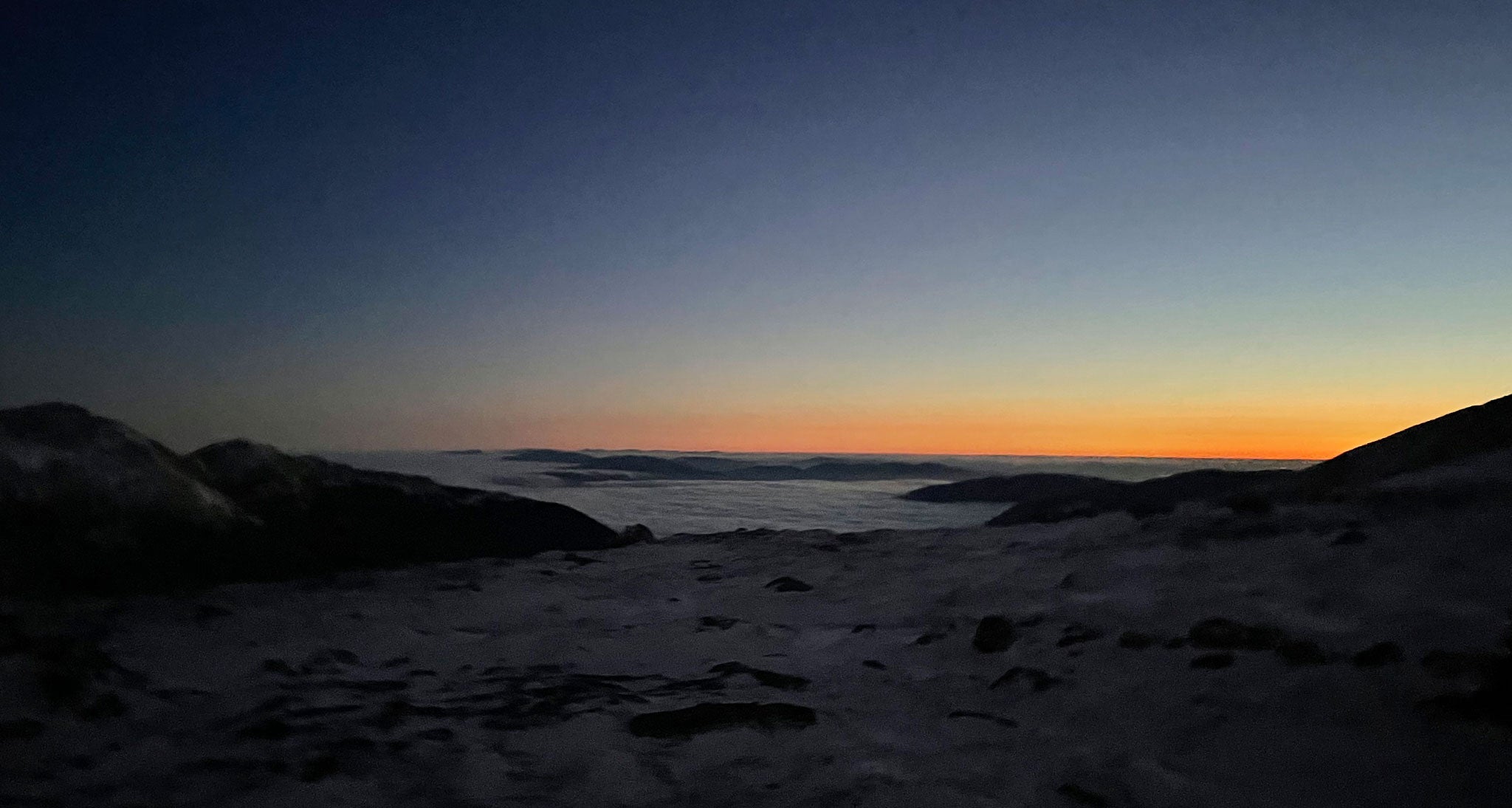Words & Photos by William Peterson
Shortly after completing the White Mountains Direttissima, which you can read about HERE, a friend came to me proposing a single day White Mountains Hut Traverse. Connecting the eight AMC High-Huts is a 54-mile endeavor with around 18,000 feet of vertical gain, and it covers some of the most rugged terrain on the East Coast, including Mount Lafayette and the Presidential Range. Foolishly, I jumped at the opportunity because I did not want to back away from an honest challenge.
Beyond not allowing myself to recover from the Direttissima physically, I lacked a purpose–a “why”– for attempting a Hut Traverse. These factors added up to a failed attempt at the Traverse wherein I quit after 30 miles.

Okay, score one for the Hut Traverse. As I sat with this failure for weeks and months, a “why” began to develop. I became increasingly frustrated that I’d allowed myself to reach a mental space in which quitting seemed like a viable option. Fair or not, I felt as though the Hut Traverse had defeated me, and I hated that thought. To make up for it, I felt as though I needed to not only complete a Hut Traverse but up the ante. After extensive research, I settled on my winter project, a single-day Winter White Mountains Hut Traverse.
At the time that I decided to take on this project, it had only been completed once before, in 2013 by Adam Wilcox, and for good reason. The Hut Traverse is a gnarly route under the best of conditions, but many miles of the route are sparsely traveled in the winter, and the extensive time above treeline can lead to dangerous conditions due to the notoriously unstable weather in the White Mountains. I was also keenly aware of my lack of winter hiking experience, which had been relegated to sub-14-mile days on the easier 4,000 footers and some challenging 3,000 footers.

Twice early in the winter, on January 3rd and 9th, I made unsuccessful attempts at the Traverse (three points Hut Traverse, zero points Will, if you’re keeping score). However frustrating, these attempts didn’t leave me nearly as downtrodden as the first attempt for two reasons. First, I was learning an incredible amount about winter hiking with each attempt. Second, these unsuccessful attempts were more a consequence of unfavorable weather/trail conditions than mental weakness.
I knew that I had it in me, but I also knew that I might need to be patient. I knew that the third attempt would be make or break because I likely wouldn’t try a fourth time in a single winter. I took a step back, planned meticulously, and waited. Nearly two months later, on March 8th, I saw my opportunity and took it.

I departed the 19 Mile Brook trailhead at 2:05 am, making the four-mile trek up to the Carter Notch Hut, where the Traverse would officially begin. I departed the Carter Hut at 3:28 am, and from that point forward, I was on the clock until I completed the Winter Hut Traverse, 19 hours 29 minutes later.
The conditions ranged from incredible to brutal. Fortunately, the first half of the Traverse had much more of the incredible conditions. Much of the second half consisted of pushing through thick treetops on hardly trafficked trails, but by the time I hit these brutal sections, I had far too much invested to even consider anything but finishing. By mile 46 (in the pitch dark and with over 15 miles of harsh trail conditions), I was physically tanked and bonking hard. Luckily, my friend Bill Tidd joined me for the last few miles, providing me the mental boost I needed to make the final push over Mount Lafayette, down to Franconia Notch, and up to the last hut. Two other experienced hikers also completed the Traverse this winter, making me the 4th person to complete the single-day project.

When it comes down to it, these sorts of experiences are only as valuable as what you learn along the way, and boy, did I learn a lot this winter. There are many factors that add up to a successful or unsuccessful day of winter hiking, whether it be a 54-mile slog or a six-mile peak bag. First, let me say that I am not by any means an expert at winter hiking. That said, I hope that perhaps others can learn from my mistakes and my personal experiences to enhance their winter hiking experience. In that spirit, here are some of my biggest takeaways from the winter:
Figure out your water system. Have it nailed down 100%, and be comfortable with it. I used insulated, zippered sleeves for my Nalgenes on my first attempt at the winter traverse. While it kept my water from freezing, it was energy and time-consuming to take the bottles out, unzip the sleeve, and unscrew the lid every time I needed to drink. On the second attempt, I tried to use a hydration bladder with homemade insulation, and my water froze in less than 30 minutes.
Finally, after discussions with Bill Tidd, I settled on a system wherein I wore my hydration vest under my coat and ran the tube up my sleeve, thereby using my body heat to keep the water from freezing. Perhaps there are better methods, and I’m not claiming to have the best one. However, it is definitely important to develop a system that makes you certain that your water will be easily accessible and in the preferred liquid state.
Next, it’s not just about the weather on a given day. What was the weather like yesterday? The day before? On my first winter attempt, I was anxious to get going and jumped on a day with clear weather. However, the day before saw seven inches of fresh snow, and this accumulation was blown into knee-high drifts at higher elevation. Over a long winter day, the conditions of the snow under your feet matter just as much as the weather above your head.
Third, don’t be afraid to swap between boots and snowshoes fairly regularly. Especially in the presidential range, which is almost always windblown, I found that there were sections of totally bare rock and other sections with deep drifts. Thinking I would lose significant amounts of time by changing between snowshoes and bare boots, I simply kept my snowshoes in my Windrider and trudged through the drifts on my first attempt. Ultimately, this led to my pace slowing due to fatigue. Simply keeping the snowshoes on is also a viable strategy if the distance between the bare spots and the drifts is relatively small, but snowshoeing over rocks for an extended period of time damages the snowshoes and becomes quite annoying.
Last, and probably most important, be patient. It is a sentiment that has been clichéd to death, but the mountains will always be there. Being patient can be very difficult. I’m personally pretty terrible at it; it doesn’t satisfy your pent-up stoke, and it doesn’t get you any plaudits from those you know. But if you want to put yourself in the best position to achieve your goals, you have to be willing to understand when the natural world is saying, “Not quite yet!”
Will Peterson is a thru hiker, trail runner, alpine skier, peak bagger, and a Behavioral Neuroscience student at Northeastern University. He hopes to continually push himself to new limits on the trail and in the mountains. Follow him on Instagram @_will.peterson























